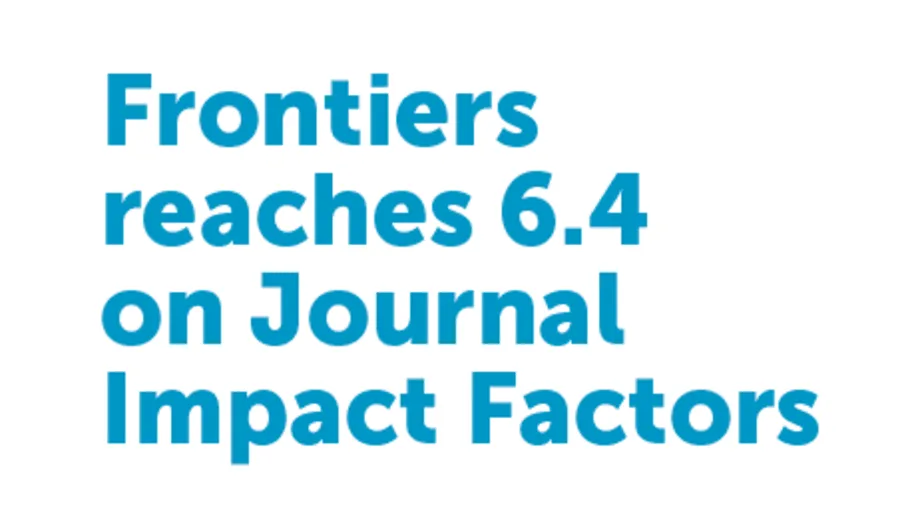
- Science news
- Impact analysis
- Quality and Impact Analysis: Frontiers in Physiology
Quality and Impact Analysis: Frontiers in Physiology
By Pascal Rocha da Silva, Frontiers analyst
Frontiers in Physiology was launched in 2010. In just 4 years, it has become the second largest and the 4th most cited Physiology journal in the world****.
The impact factor (IF), defined as the total number of citations divided by the number of citable articles over a two-year period, is the gold standard of journal quality (not of an individual scientist). It was formally established by the Institute for Scientific Information (ISI) in 1975. As the IF can be heavily skewed by a few highly-cited papers, total citations generated over the same two-year period provide a more accurate measure of the overall influence or impact of the articles published by a journal in a field.
Analysis within the category of Physiology
There are 83 journals listed in the category of Physiology in the 2014 Journal Citations Reports (JCR) provided by Thomson Reuters in 2015. Frontiers in Physiology is one of the 10 Gold open-access journals.
Below, the results of our comparative analysis on the article volume published, impact factor (IF) achieved, and the total number of citations accumulated in 2014 based on articles published over the two preceding years, 2012 and 2013. (Click here to see the volume and number of citations of other Frontiers journals).
Comparison of impact factors and volume among all open-access journals (10) in Physiology

Figure 1. Frontiers in Physiology compared to 10 open-access journals listed in the Physiology JCR category. The journal analysis is based on the 2014 Journal Citations Reports published by Thomson Reuters, 2015.
Comparison of impact factors and volume among all journals (83) in Physiology

Figure 2. Frontiers in Physiology compared to all 83 journals (subscription and open access) listed in the Physiology JCR category. The journal analysis is based on the 2014 Journal Citations Reports published by Thomson Reuters, 2015.
Comparison of total citations in 2014 for articles published in the previous two years among all journals (83) in Physiology

Figure 3. Top 20 most-cited journals in Physiology in 2014 (citations in 2014 were counted for articles published in 2012 and 2013) in the Physiology JCR category. The journal analysis is based on the 2014 Journal Citations Reports published by Thomson Reuters, 2015.
Summary
Amongst the 10 Gold open-access journals listed in the categories of Physiology, Frontiers in Physiology:
Ranks 2nd on impact factor
Is the largest open-access journal in Physiology – 4.2 times larger than the average article volume in Open-Access journals in Physiology
Amongst all of the 83 journals listed in the category of Physiology, Frontiers in Physiology:
Is in the top 24% on impact factor
Is the world’s 2nd largest Physiology journal overall – 4 times larger than the average article volume in all journals in Physiology
Is the 4th most-cited journal in 2014 based on articles published in 2012 and 2013
Further significance
The results are more significant if one considers:
Frontiers does not engineer the IF by setting a rejection rate, and instead operates an impact neutral peer-review process.
In just 4 years, Frontiers in Physiology has become the 4th most-cited journal in Physiology with an impact factor in the top 24%.
In summary, Frontiers in Physiology, one of the youngest journals publishing peer-reviewed scholarly articles in Physiology, has become the 2nd largest and 4th most-cited journal in Physiology with an impact factor in the top 24%.
Key to success
At Frontiers, we publish all articles that are scientifically correct. We engineered the Collaborative Peer Review with a review mandate focused on enhancing article quality by means of rigorous and constructive feedback from expert reviewers, quick and direct interactions between authors, reviewers and the editor enabled by our review forum platform, and we enhance transparency by acknowledging reviewers and editors on the published articles. This performance analysis indicates that the impact neutral Collaborative Peer Review conducted in Frontiers together with an outstanding editorial board has become a powerful model for publishing academic papers.
All of this is only possible with a stellar editorial board of researchers (see infographic). Frontiers congratulates Field Chief Editor George E Billman, the outstanding board of Specialty Chief Editors and all of the Associate and Review Editors (http://journal.frontiersin.org/journal/physiology#editorial-board) for this spectacular achievement_._
Frontiers in Physiology fact sheet (as of November 2015):
Website: | |
Launched: | 2010 |
Impact Factor: | 4.031 |
Number of sections: | 22 |
Number of Research Topics: | 169 |
Number of editors: | 4,272 |
Number of articles published: | 1,911 |
Number of article views: | 147,672 |
Number of article downloads: | 49,863 |
Chief Editors (see full board):
George E Billman, The Ohio State University | Field Chief Editor, Frontiers in Physiology
Andreas Fahlman, Texas A&M, Corpus Christi | Specialty Chief Editor, Frontiers in Physiology –Aquatic Physiology
Joel C Bornstein, The University of Melbourne | Specialty Chief Editor, Frontiers in Physiology –Autonomic Neuroscience
Vaughan G Macefield, Heidelberg University | Specialty Chief Editor, Frontiers in Physiology –Autonomic Neuroscience
Dieter W. Heermann, Western Sydney University | Specialty Chief Editor, Frontiers in Physiology– Biophysics
Ruben Coronel, Academic Medical Center, Amsterdam | Specialty Chief Editor, Frontiers in Physiology – Cardiac Electrophysiology
Johannes van Lieshout, University of Amsterdam | Specialty Chief Editor, Frontiers in Physiology– Clinical and Translational Physiology
Raimond L Winslow, The John Hopkins University | Specialty Chief Editor, Frontiers in Physiology – Computational Physiology and Medicine
Thimios Mitsiadis, University of Zurich | Specialty Chief Editor, Frontiers in Physiology –Craniofacial Biology
Gary Iwamoto, University of Illinois at Urbana-Champaign | Specialty Chief Editor, Frontiers in Physiology – Exercise Physiology
Gregoire P Millet, University of Lausanne | Specialty Chief Editor, Frontiers in Physiology –Exercise Physiology
Bruce J West, U.S. Army Research Laboratory, Durham | Specialty Chief Editor, Frontiers in Physiology – Fractal Physiology
Stephen J Pandol , University of California, Los Angeles | Specialty Chief Editor, Frontiers in Physiology – Gastrointestinal Sciences
George E Billman, The Ohio State University | Specialty Chief Editor, Frontiers in Physiology –Integrative Physiology
Geoffrey A Head, BakerIDI Heart and Diabetes Institute, Melbourne | Specialty Chief Editor,Frontiers in Physiology – Integrative Physiology
Sylvia Anton, Institut National de la Recherche Agronomique | Specialty Chief Editor, Frontiers in Physiology – Invertebrate Physiology
Daniel Gaudet, University of Montreal | Specialty Chief Editor, Frontiers in Physiology –Lipidology
Mario L Diaz, Universidad de La Laguna | Specialty Chief Editor, Frontiers in Physiology –Membrane Physiology and Membrane Biophysics
Paolo Bernardi, University of Padova | Specialty Chief Editor, Frontiers in Physiology –Mitochondrial Research
Shruti Sharma, Georgia Regents University | Specialty Chief Editor, Frontiers in Physiology –Oxidant Physiology
Steven Carl Huber, United States Department of Agriculture – Agriculture Research Service | Specialty Chief Editor, Frontiers in Physiology – Plant Physiology
Andreas P M Weber, Heinrich-Heine-Universitaet | Specialty Chief Editor, Frontiers in Physiology– Plant Physiology
Robert John Unwin, University College London | Specialty Chief Editor, Frontiers in Physiology– Renal and Epithelial Physiology
John T Fisher, Queen’s University Kingston | Specialty Chief Editor, Frontiers in Physiology –Respiratory Physiology
J Alberto Neder, Queen’s University Kingston | Specialty Chief Editor, Frontiers in Physiology –Respiratory Physiology
Paul M L Janssen, Ohio State University | Specialty Chief Editor, Frontiers in Physiology –Striated Muscle Physiology
Peter J Reiser, Ohio State University | Specialty Chief Editor, Frontiers in Physiology – Striated Muscle Physiology
Hiroaki Kitano, The Systems Biology Institute | Specialty Chief Editor, Frontiers in Physiology –Systems Biology
Aldana Maximino, Universidad Nacional Autonoma de Mexico | Specialty Chief Editor, Frontiers in Physiology – Systems Biology
Raina Robeva, Randolph-Macon College and Sweet Briar College | Specialty Chief Editor,Frontiers in Physiology – Systems Biology
Gerald A Meininger, University of Missouri | Specialty Chief Editor, Frontiers in Physiology –Vascular Physiology






